#differences in linguistic roots aside
Text
Peter Parker swearing:

"Holy @$#%%" - ("Holy shit") (Amazing Spider-Man #597)
—

"@☆xxx%#@ bureaucrats!" - ("Goddamn/Fucking bureaucrats!") (Amazing Spider-Man #244)
—

"#$%& me" - ("Fuck me.") (Amazing Spider-Man #798)
—

"#^&$!&!! Johnny Storm and then %#^@$#$&@! his %@#$^!!" - (your guess is as good as mine) (FF vol 1 #17)
—
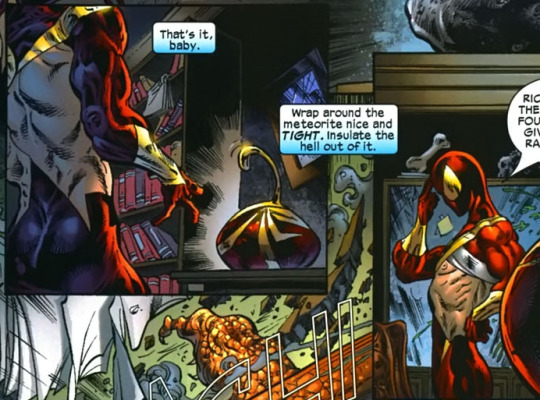
"Insulate the hell out of it." (bonus dirty talking his own suit, with his tits out) (Sensational Spider-Man vol 2 #27)
—

"Aw, #$%&." ("Aw, shit," knowing Slott's Whedon-esque dialogue patterns, but I'm choosing to read it as "Aw, fuck" instead) (Spider-Man vol 4 #10)
—
Will add more as I come across them.
I'm trying to amass a collection... literally no reason other than "for funsies" lol — so on the off chance anyone wants to send me any other scenes of Peter swearing or saying questionably inappropriate things, feel free! i just ask you to keep it to 616 comics peter/spidey only, preferably, and please include the issue number 🙏
(also don't send me the panel of Ben cussing out a news reporter (iirc), or panels of Kaine. I'm not putting them in this post cause that doesn't count as Peter; they're different people.)
#nadia reads comics#peter parker#spiderman#I have ideas of what he might be saying in FF no 17 but ultimately it's a mystery#fuck johnny storm and fuck his corpse?? maybe?? or some kind of unspeakable violence that must be censored#(or at least is censored to give the impression that it's the worst thing the reader can think of someone saying XD)#perhaps something about castration?#i almost included the panel where he says ''Me¸ I'm fagged out.'' from marvel team-up no 9 but idk if i consider that swearing necessarily#differences in linguistic roots aside#peter swearing#to make this easy to find and edit#have i mentioned lately that i think dan slott is a bad writer?
182 notes
·
View notes
Text
Where do Jews pray?
Aside from the "technically true" answer of 'wherever they happen to be' this is going into the words used English for the specifically chosen buildings.
You run into a few different common ones:
Synagogue, Temple, and Shul.
Each have different histories, and implications that many people may not know.
So I want to break down the etymologies, implications, etc. as well as mention some less well known ones.
1)Synagogue: Linguistically arguably the most correct.
It comes from from french, latin, and ultimately greek, and ultimately is from the translation of the Bible into Greek.
The word be created as a translation for the word Knesset.
It literally would translate (in the original greek) to 'meeting place'.
overall: 10/10, cannot go wrong with using this word.
2)Temple: A fairly Common word, but one that is rife with theological implications that many are unaware of.
Basically it goes like this:
There was the first temple and the second, and we are waiting for the third (in theory).
When the Reform movement started, one aspect was that the Temple was no longer felt to be a necessary and lamented missing aspect of Judaism, and that the places of prayer were equivalent.*
So they began to call their Houses of Prayer 'Temple's.
No one in the Orthodox movement would use that term, nor would people in the Conservative movement call their houses of prayer 'Temple'. (at least none that I have seen, and very much none at the begining, I am sure that there are some conservative shuls nowadays that do use the term 'temple').
Now, this means that the use of the word 'temple' to describe a Jewish house of worship is also a theological position.
So hearing people use the term 'Temple' as a catch all term instead of Synagogue will annoy a lot of more religious Jews.
Now there are a few disclaimers about this:
99% of people aren't aware of this.
I have met many a reform and conservative individual that was unaware of the history.
So like all pieces of information on a small aspect of theology, don't assume a use of a term implies full knowledge of ramifications.
Of course, there is the other issue "Temple" refering to loads of other religions' houses of worship, so it isn't really a good identifier.
2/10, find another word people.
3)Shul A loan word from Yiddish, it actually is the same linguistic root as 'School'. A place of learning.
I like it, but a lot of people won't know it, so you'll need to then translate the word.
8/10, but I am biased.
Other words that you may see:
Jewish Church: The issues are obvious, but for some reason I like it.
Beit Knesset: The Hebrew word, 'House of Meeting' it's good, but y'know obv. issues of using hebrew in english.
*I am summarizing and simplifying a large religious movement, obviously this misses some nuance.
19 notes
·
View notes
Note
Did Europe got it's name from the ancient Greek myth Europa? Where Zeus fell in love with her disguised himself as a cow and then kidnapped her?
It did, although not so directly.
It was usual for Ancient Greeks to associate regions with a progenitor, who was a mythological figure, so as to explain the differences between different people and genealogies. While Europe was of Greek descent according to the myth, she was a princess of Phoenicia. Zeus kidnapped her and took her west to the island of Crete, where she became its queen and progenitor (she was the mother of King Minos). It’s interesting that the selection of Crete might indicate some kind of awareness Ancient Greeks had that Crete was one of the very first places in Europe / the West with advanced civilisation. In any case, in the Homeric epics the name Europe is used broadly for the land west of the Aegean Sea. That includes the Greek mainland and perhaps the Balkans and East Europe. However, as it is evident in the maps of Anaximander in the 6th century BC, the definition of Europe had expanded to include more of the western parts of the continent.

The potentially first map of the known world is attributed to Anaximander (6th century BC).
So, the knowledge on this map apparently was passed on to the Romans and most of the continent eventually. Therefore, Western Europeans most likely adopted the definition of the Greeks for the region and it’s not that they took it directly from the kidnapped mythological princess.
By the way it was also the Romans who changed the character’s name into Europa as in Greek it is the same with the continent’s name: Ευρώπη (Europe - Greek pronunciation is Evrópi) .
Setting the myth aside and trying to find a more down to earth approach, it is not yet certain why Greeks called Europe as such. Ευρώπη is a compound name from the adjective ευρύς (eurus or eurys, pronounced evrís) and the suffix -ώπη (-ope) which comes from the roots of the words for vision, eyes, looking (i.e compare with optics, ophthalmology, optometry etc). Historians and linguists are basically at a loss because they don’t yet understand why that name would be associated with the continent. Regarding the mythological princess, her name can mean that she had wide, large eyes or that her eyes were widely set on her face or that she had a wide face (as the Greek word for face has the same root, πρόσωπο - prósopo, literally meaning “frontal look”). That’s all well for her but why would the continent be called that? This is unclear and it is important because it’s mythology that explains real life, not the other way round. This is just my personal speculation but I believe the true name might have the meaning of “wide view”. In Greece, there are locations which have similar names, the most notable being Ancient Europos in Macedonia, Northern Greece. More locations had been named as such in colonies during the Hellenistic era, i.e there is one in Syria. If it was such a popular name for locations and towns, I believe the name described the settlement as having wide, expanding views and potentially good visibility against invaders. Or maybe that it was widely structured itself and expanded before the visitor’s eyes. The more I think of it, the more obvious it gets and it pains me that acclaimed scientists fight over why a continent has wide eyes or names itself after a woman raped by a horny god. It almost certainly has little to do with it in the grand scheme of things. The way Greece is a narrow peninsula, progressively widening towards its north and then the Balkans and Central Europe widening even more could possibly be the reason why anything from Greece’s viewpoint and farther north was called “wide looking”. Besides, if we judge from Anaximander’s map, it is obvious Greeks in the 6th century BC thought Europe was the largest continent as they had explored Africa (Libya) and Asia far less (they probably gave up in Sahara and the Middle East). Therefore in the Greeks’ perception, Europe indeed appeared like a wide, expanding land. By the Hellenistic era, where they had explored more and the knowledge was certainly far better, I assume the name had stuck anyway and did not change. I don’t know when exactly Europeans “officially” embraced the term but I believe the inspiration was historical (the ancient maps) and not mythological.


Ancient Europos. I suspect it is not coincidental at all that it is so flat with so wide openings to the horizon from all sides. This would be notable enough to be named after, as so flat and widely mountain-less areas are rare in the Greek terrain.
In conclusion, my speculation is that the myth somehow attempted to interpret the procession of advanced civilisation (or maybe just Greek presence) from East to West, and the flourishing of Greeks there like Europe eventually did with Zeus’ gifts and sons. Even if I am totally off, I still believe it makes more sense if the mythological connection was attempted after the name Europe was already used by at least a number of Greeks as a geographical term and not that Europeans read Europe’s story and were like “seems like the perfect name for our continent”. Again, mythology is the one observing and interpreting the already existing world.
#Europe#Greece#mythology#Greek mythology#zeus#ancient europos#Macedonia#kilkis#Crete#mainland#Greek islands#Greek history#anon#ask#anaximander
77 notes
·
View notes
Text
This is part 21 of the "What if Yuu didn't want to go back?" Series!
(I, the author of this work, do not consent to this work being crossposted/translated without my knowledge or used to train an AI, ever.)
Masterlist
"Goodnight, Yuu," whispers Grim.
"Goodnight, Grim," I whisper back. Korrak and Mandible are already asleep, and we dare not wake them.
A moment passes. "Grim, do you want to try and find another big stick tomorrow?"
"Hehe. Yes."
And then our eyes close.
It only feels like a moment later that we're up and walking again, back in the Backstage Room for our usual morning routine. The walk there is muscle memory at this point, so we arrive a minute earlier than Epel. Interestingly, Korrak isn't there, even though he and Mandible were out of bed when Grim and I woke.
Meh. I'm too tired to think about that and add it to my mental list of clues in the quest to unravel the mystery that is our human roommate and his 'possum familiar.
More people file in as I brush Grim's fur to the smooth and silky shine that is expected and achieved daily by every furry familiar in Pomefiore. I'm still half-alseep when I squeeze a dash of kitty toothpaste onto Grim's kitty toothbrush, but that doesn't last.
With my own hair brushed and Epel on my left, I think it's going to be a normal day. Still, something feels off. Very off. I'm unsettled, and I don't know why.
Then it hits me. Slowly, like something oozing onto my head, it hits me. If Korrak has pilot parents, then why did he do so well against Floyd?
This is going to keep eating at me until I solve it. Sigh. And I have classes today.
" 'Ats th'matter, Yuu? Yer lookin' pretty worn-out, an' th' day ain't even really started."
"Myeeh. Classes."
Epel looks at us, confused- before laughing. "We ain't got no class t'day, 's a weekend!"
Grim and I both thank whatever forces gave us a day off. Epel, Grim and I hurry through our routine and go to breakfast- eggs on toast.
I still haven't seen Korrak or Mandible today.
Before I can properly register it- or wake up- Grim and I are adventuring through the woods outside our dorm, continuing our quest for a stick.
We carefully dig through the leaves before I step anywhere, exercising all the caution we feel we'll need to ensure the perfect stick does not escape our notice nor break before we may properly obtain it.
The woods are peaceful. Grim has dismounted from my shoulder in favor of trotting along the forest floor, through the yellow-brown that carpets the grass and tree roots.
His ears perk up. He looks suspiciously at nothing, head turned, and then calms, ears lowering. Still, he's clearly on edge.
I've got a feeling about this. It's a little dread, settling in my stomach like tar, but there's also some determination, sitting atop the dread like snow.
The question about Korrak is still eating at me. It's harder to ignore now that the sleep has left my eyes and mind, but I'm setting it aside nonetheless to search for the stick. Still: why would he lie? Did he even? Maybe it's just redacted information he's not comfortable sharing, as opposed to an outright lie. Maybe his parents taught him self-defense.
But... that didn't look like professional self-defense. It looked like something learned on the streets- but how would I know? I'm new to this world, maybe that's just what their jujustu looks like.
What's that? It sounds like... chittering. I look at Grim. He's facing roughly north, at the source, ears pointed forward. He makes eye contact with me. The message is clear: I'm not just dreaming. There's something- or someone- out there.
Hold on. More chittering? It sounds... different, somehow. A different voice? Wait. That sounds a lot like Mandible. And the other voice is talking now, could that be...Korrak?
What language could that be? Not French, that's for sure... maybe something else?
Wait. I've heard people talking about an "Animal Linguistics" class. If animals have their own language... and Mandible is an opossum...
Grim and I make eye contact again. He's connected the dots, too. Another question: why is Korrak speaking opossum? I've heard other people talking to their familiars during meals and in the Backstage Room, but they don't speak the animal language- they speak their human language, and the familiar chirps, barks, chitters, or otherwise make animal sounds back. I often can't understand either side; a lot of Pomefiore people speak Dutch or Spanish or something.
This mystery just keeps expanding. My mental pinboard has even more yarn on it now, and no extra answers.
The chittering has stopped. Maybe that wasn't Mandible and Korrak? Meh. We have a stick to find!
The woods are pretty and peaceful. Leaves crunch underfoot and underpaw, respectively, and rocks must be carefully avoided- lest I fall over. Grim is a quadruped, so he doesn't have that risk.
Ow! Tree roots. I also have to watch out for tree roots. Wish I remembered that before I fell flat on my face, but it's a little late for that.
"Are you okay?" I know that voice. That's Mandible.
"I'm fine," I start, lifting myself from the leafy forest floor. But, before I ask about what was overheard, I catch myself. They probably wouldn't react well if I asked.
Wait... this is a new area of the forest. I'm standing on the edge of a clearing, set in an indent in the ground, like a reverse hill. The inside of the bowl-like shape is all leaves, with some decent-sized boulders around the edges. One, two... Thirteen boulders, arranged in a circle. Some have sharp edges, others appear entirely smooth. All are grey, but various shades- some are far darker than others. A few even look to have stripes, like the igneous rock I learned about in middle school science class. It's very pretty.
There's an indent in the leaves- a path where someone walked. This must be where Korrak was earlier.
"What are you two doing out in the woods?"
Before I can respond to Mandible's question, Grim jumps in for me. "We're gonna get a big stick to make into a toy!
"Oh, that sounds fun! I think I saw one over here!" Mandible hops down from Korrak's shoulder and trots down the steep slope, into the clearing. I follow, take one step down, trip again, and fall- a hand wraps around my right wrist, and I realize I'm pulling Korrak down with me. He's strong, but gravity and momentum are stronger.
I hit the ground first. My arm breaks my falk for most of my body, but my hips don't get that, and throb with dull pain. I don't feel blood. Then, Korrak hits the leaf litter- and exclaims something when he does. It's not English, but the chittering we heard before. He sounds indistinguishable from an actual opossum.
Oops. I'm staring. And he's noticed, too. Time to try and pass it off as an "I was worried" thing.
"Myeeh! Are you two okay? Yuu? Yuu!"
Well, Grim's beat me to it. And, oddly enough, Mandible is chittering at Korrak. I think he's asking if we're alright.
I stand, stretch, and offer Korrak my hand. He takes it, and I lift him. "You good?"
"S-sure am. Thanks." He pauses. "Are you?"
I nod. "Yeah. Sorry about that."
"Yuu! Do you need ice?! I can summon some!"
"Don't, Grim."
Korrak is looking at me now. "You're pretty fluent in Cat."
I look at him, right into his smokey grey eyes. "What?"
"You're p-pretty fluent in Cat. I'm impressed."
"What do you mean by that? How can I be fluent in a species?" Only after the words leave my mouth do I remember Animal Linguistics is a class.
Korrak bursts out laughing. "Animals have languages. You seem p-pretty fluent in Cat, especially considering it's not y-your native language. That's what you and Grim are speaking. What's h-h-he saying, anyway?"
"He's asking if I need ice and offering to summon some."
Korrak laughs. "G-good ol' Grim."
"By the way, what did you mean by 'not my native language'?"
He pauses, nervous. "W-well, I'm assuming your native language isn't Cat. You seem f-fluent in it, th-though."
"I'm assuming the chittering is you and Mandible speaking Opossum, then."
Korrak nods. "Y-yeah. It's my, um.. Nevermind."
He whispers the last part, just a faint draft of breath, but my ears catch it anyway. Grim's do, too. This time, I take notice of how his words sound- he's speaking Cat.
"Your what?"
"Your what?" I echo his words, in English this time.
"N-nothing." That's a sound he doesn't usually stutter. He's nervous.
I give him a look. He doesn't cave, not yet.
"Found it!"
"Myeeh, that's too thin... maybe. Hey, Yuu, over here!"
I walk over to Grim and Mandible to look at the stick. It's wildly thin, and is shaped like a paperclip someone tried and failed to straighten out. It's not going to work.
"Yeah, too thin. Thanks for trying, Mandible." I spare a glance at Korrak. He's still standing there, nervous. I'm a little scared to leave him alone. Not completely alone, obviously- he'll still have his familiar- but an opossum can only do so much, and... sigh.
"Come on, hench-human. I wanna see Sam's. I heard there's a tuna discount!"
Of course, he's thinking of tuna. His favorite food. He's never told me, but, in the other world, my Grim loved tuna beyond any other food. He loves it here, too.
Maybe we'll run into Rook there; we can ask him for help if we do. Hey, that's right- Rook is probably here somewhere, supervising. Korrak will be okay.
I laugh. "Alright, Grim, let's go and look."
Taking one last glance at the nervous, purple-haired boy and the furry marsupial, we leave the little bowl clearing behind us, questions put aside in our heads.
#twst#disney twisted wonderland#twisted wonderland#disney twst#m!yuu#twst yuu#twst grim#twst oc#what if yuu didn't want to go back
10 notes
·
View notes
Note
I mean fermented doesnt necessarily mean alcoholic - after all kimchi is made with fermented cabage and bread is fermented too. So is yogurt and a ton of other things we eat. Theres even some meats that are fermented for dishes too.
This is very true! And I did look into a couple of other things that are fermented-- but the problem with cats having anything fermented at all is yeast.
(CW: I talk about yeast, fermentation, alcohol, and the horrors of what yeast can do to a cat's belly. Skip this one if medical discussion of a cat in pain upsets you!)
In fact it's good you mentioned bread, because I was just looking at different types of unleavened bread exactly for this reason. If a cat eats raw dough, yeast can actually ferment in their stomach! This does exactly what you think it would, it turns their body into a chemical nightmare, distending their belly and causing alcohol poisoning
(doing research for these projects is like taking a class on how DURABLE human being are, it's insane! This isn't even unique to cats! Pure carnivores are so fragile!)
The baking process would kill all the yeast inside of the bread, but I decided that I would just not work with it. Unleavened bread and alternate rising agents are cool so I decided to explore those instead. I even found this one really interesting tidbit about how apparently bannock from Britain and bannock from American Indigenous people in America may have evolved independently, down to the linguistic roots being different.
BUT ANYWAY back to yeast
So when I was looking at fermented products, I was looking for things where there isn't yeast present, but also checked off my other rules; namely, that Clan cats are obligate carnivores.
-Kimchi is fermented vegetables, a lot of work for a Warrior to get no nutritional value. Not to mention that without pepper, garlic, and fish sauce it's just... sad cabbage. (also go watch this cool video I found about one of the last traditional onggi pot makers left in Korea because this is actually a very beautiful craft and my life has been enriched by seeing how much care goes into this process)
-This also eliminates sauerkraut, which is a more region-friendly take on fermented cabbage. No nutritional value to the cats.
-Miso can be made from barley but it requires a region-unfriendly type of fungus (Re: The reason I usually start with British tech and work backwards, another example of this principle in action)
-Yogurt and Cheese are dairy products. Warriors are lactose intolerant to begin with, but also don't have an animal they can milk on a regular basis. I don't think a nearby sheep or cow would stay still long enough for a warrior to sit and milk them
What I DID find that we could make, though?
-Vinegar. As long as it's used sparingly and diluted, it can be used as a basis for other recipes including Worcestershire sauce. Though from what I read, cat aversion to the smell of vinegar is legendary.
But I will rule vinegar-based sauces under the 'Stronger Stomachs' exception.
In addition, vinegar is an EXCELLENT cleaning product and something I can keep in mind as an excellent antibiotic next to honey.
-Hard sausage. Pepperoni, chorizo, salami... aside from finagling with the spices I have access to, hard sausage is totally within my reach and sounds like a perfect ShadowClan recipe.
-Something that breaks down poison. I'm willing to be a little bit flippant about the biology of one type of insect or animal to make a Warrior Cat version of hakarl, specifically because I want to show off ShadowClan's crafty food culture and how good they are at creative problem solving.
This one will be in addition to "slug-purging", because I learned some really neat stuff about how to make wild gastropods safe to eat and it'll be a really really cool thing to include in a "How ShadowClan can eat things other Clans can't" type entry
Come to think of it, fermentation would definitely be a very ShadowClan-based activity...
And lastly,
Alcohol
It just feels... wrong to me that there would be a culture of sapient cats who don't use any alcohol at all. Getting tweaked on purpose is practically the mark of a species' intelligence. Dolphins, elephants, monkeys, crows... all recorded finding ways to turn their terrible brains off.
So I do want to make an entry on alcoholic fermentation too, it's just like I said though, it'll take a while to get to because I have dumb math brain and a To-Do list.
But for right now, I've got another ask to answer that will give you a good "basic" alcohol for your cats if you so choose
#TW alcohol#Alcohol#Fermentation#Medical discussion#tw animal illness#animal illness#Clan Culture#Clan Culture Mini Entry
50 notes
·
View notes
Text
On the tangled roots of Hallowe'en...
I've noticed a ten-year-old Washington Post article making the rounds again. It theorises that British colonialism determines whether or not other countries celebrate Hallowe'en. While the timing of various waves of colonisation and immigration (and for one thing, it seems important not to treat those as identical) from Britain can often be used to trace certain cultural or linguistic patterns, with Hallowe'en, the story is a bit more convoluted than is often thought.
The ways in which Hallowe'en has spread and changed over the centuries can't be understood through just ones lens. It needs the context of other autumn and winter calendar customs, the agricultural year, the Reformation, and - especially over time - the urban/rural divide.
Let's take a deep dive...
The author seems to assume that the Hallowe'en chaos (and associated crackdowns) in parts of the US in the 19th century also occurred in Victorian Britain, and then makes the further assumption that English immigration during a resulting period of Hallowe'en not being celebrated in England is the reason for its absence in places Britain colonised at that time.
Aside from the fact that 19th century migration from Britain to the US took place in a very different context from the centuries-earlier colonisation by Britain, this seems to illustrate the pitfalls of applying the term "Victorian" to countries where Victoria was not actually Queen, and people didn't identify as Victorians, any more than Americans in 2023 would call themselves "Carolingians" on the grounds of existing while Charles III is on the throne in the UK.
In Victorian England, there was no big pushback against Hallowe'en - that would've been out of step with the spirit of the age. The Victorians lived in the century when the word "folklore" was coined, after all, and there was huge interest in cataloguing and preserving traditions, most famously those of Christmas, which by 1810 had declined, before being rehabilitated by antiquarians and given new life, above all, by Charles Dickens. The Victorians half-reconstructed, half-invented an idea of Christmas in much the same way that that we have ransacked history, folklore, fiction and commerce for Hallowe'en customs of yore in the hope of celebrating it in its ideal form.
Even if England in the 19th century had been on some perverse mission to bury Hallowe'en, there was little enough left to bury. It had for some time been in decline in most parts of England for a variety of reasons, notably the Protestant Reformation that began in the 16th century, but also the shifting of various Hallowe'en customs (notably bonfires) to Guy Fawkes Night on 5th November in the wake of the Gunpowder Plot.
The Protestant/Catholic distinction is significant because Allhallowtide - the period encompassing All Hallows' Eve on 31st October, All Saints' Day on 1st November, and All Souls' Day on 2nd November - was a Catholic tradition. And in rural Ireland, where Catholicism remained strong - and unsurprisingly, Guy Fawkes Night was not a folk celebration - the old tradition of bonfires remained attached to Hallowe'en. So the popularity of Hallowe'en in the US and Canada has less to do with what the English who settled there in the 19th century weren't doing, than it does with what Irish and Scottish settlers at the time were doing - they came from cultures in which Hallowe'en traditions remained strong.
This is particularly obvious when you read accounts of late 19th century and early 20th century Hallowe'en parties in the US, which combined aspects of the harvest home tradition (which had deep roots in Britain and Ireland) with the custom - strong in Ireland and Scotland - of divination rituals related to who you would marry and which relationships would succeed or fail. Women's magazines of the time, in their advice for hostesses, drew strongly on those traditions. In their focus on sweethearts and romantic divination, the party ideas may strike modern readers as evoking Valentine's Day rather than spooky season.
This was much more encouraged than the wilder aspects of the day. On the scale of small, rural Irish communities where everyone knew each other, Hallowe'en pranks had their place - and usually, reasonable limits. You could disassemble the village curmudgeon's cart and then reassemble it, donkey and all, in his farmhouse kitchen, but you knew nobody would be laughing if you burned his house down. And the goodwill (however strained) with which villagers tolerated absurd pranks by their neighbours' sons did not translate to city contexts, where large groups of youths engaging in higher-stakes pranks and vandalism caused real harm and real fear. It's this expression of Hallowe'en traditions that was attracting pushback in the 19th century - just not in England.
The Washington Post article cites this Quartz map to further its claims. The logic is supposed to be that countries which today have a bump in sweet imports in October must celebrate Hallowe'en. But it's a weak argument, as many of those countries - notably those in continental Europe - did not see large-scale, culture-changing British immigration in the 19th century, But they do have their own centuries-old traditions of children going from door to door - perhaps disguised, perhaps rhyming, sometimes with lanterns and often begging for sweets by way of a song.
These range from Pão-por-Deus, a souling custom children perform on All Saint's Day in Portugal, to St. Martin's Day, wherein parts of Flanders and the Netherlands, and most of Germany, Switzerland and Australia, children travel from house to house with lanterns, singing in exchange for treats. The bump in sweet imports seems more likely to be due to their own homegrown traditions, combined with more recent adoption of Hallowe'en, and the tendency for major retail chains to stockpile ahead for Christmas.
And these autumnal singing/guising/begging traditions in themselves are part of a broader, older and geographically widespread tradition of guising and mumming (by adults, also), often during the darker months - one that often coalesces around Christmas or New Year (as in mummers' plays).
We think of Hallowe'en as occurring squarely in the autumn, particularly with climate change causing unaccustomed mild weather and the shops bringing out Hallowe'en products earlier and earlier. But it traditionally marked the start of winter, and it's not coincidence that St. Martin's Day, as celebrated in various parts of mainland Europe, falls on what was originally Samhain Eve.
This makes more sense when you understand that the calendar itself has changed over the centuries. In Jack Santino's book The Hallowed Eve: Dimensions of Culture in a Calendar Festival in Northern Ireland, he observes that:
"In the old Celtic calendar, November 12 was the first day of the year. The adoption of the Gregorian calendar in 1752, with its dropping of twelve days, meant that some traditions associated with November 11, Samhain Eve (later known as Old Halleve), were now observed on October 31. Hiring fairs were held on November 12 and May 12, and parties were given on Old Halleve to celebrate the end of the six-month hiring term. The tradition was also related to the potato harvest."
I'm writing this as the clock ticks from the 11th to the 12th of November, and it certainly does feel more wintry now. By this stage of the year, back in the days of the old calendar, the days would have been shorter and darker for a good while, your crops and your cattle would be safely gathered in, and whether you marked the turn of the year with Hallowe'en or St. Martin's Day, a lantern was a welcome thing in the cold and dark.
1 note
·
View note
Text
Chapter 2: Grammar

Singlish, the colloquial English spoken in Singapore, and Philippine English, a widely used form of English in the Philippines, exhibit notable differences in their grammatical structures.
While both languages are rooted in English, their evolution within their respective cultural contexts has led to distinct grammatical features. These differences not only reflect the unique linguistic pathways of each variety but also provide insights into the cultural and historical influences that have shaped them.
In this chapter, we will delve into some of the key grammatical distinctions that set Singlish and Philippine English apart.
Linguistic Morphology
The rules of verb tenses and plurals, as well as a lot of grammatical endings in standard English are optional in Singlish. e.g:
“What happen yesterday?” (What happened yesterday)
“Got so many car!” (Got so many cars)
“Then bicycle go first ah.” (So the bicycle went first)
While tenses are often omitted in Singlish, Philippine English often interchanges the usage of tenses in their sentences.
Present perfect is used in the place of simple past:
“I have seen her yesterday” (I saw her yesterday)
Past perfect is also used when present perfect is expected:
“He had already gone home” (He has already gone home)
Lastly for tenses, present continuous is often used instead of simple present when referring to habitual verbs:
“She is driving to work every day.”
Aside from this aspect of grammar, Philippine English is often similar to Singlish on how it modifies plurals, with Philippine English often ignoring standard English rules for singular inflection of verbs. e.g.
“One of the boys give a report to the teacher every morning.”
Articles
Both Singlish and Philippine English have the common aspect of using articles differently. Singlish usually omits definite articles, e.g.
“You go to restaurant”
Philippine English articles are often modified in their speech as well.
“He is going to United Kingdom to study at the Oxford University”
Syntax
Similarly to mandarin speech, it is frequent for syntax in Singlish to be shortened or abbreviated. e.g.
“Like that also can” (You can also do it like that)
This form of shortened syntax is also evident in Philippine English grammar. This is evident in the use of transitive verbs, where generally transitive verbs are used intransitively. e.g.
“Did you enjoy?”
“They cannot afford.”
“Do you like?”

Particles
Singlish in Singapore and Philippine English in the Philippines both rely on unique particles in daily conversations, shaping nuances, tone, and cultural expressions. Here are a few examples of these particles in Singlish:
LAH
Singlish often uses "lah" to emphasize or add urgency to statements, such as,
"Hurry up lah, we're late!"

LEH
In Singlish, "leh" softens a statement or seeks confirmation, as in,
"This food is nice, leh."
MEH
Singlish uses "meh" to express doubt or turn a statement into a question, like,
"You think he's telling the truth, meh?”
Here are some particles in Philippine English:
PO AND OPO
In Philippine English, "po" and "opo" are polite markers, as seen in responses like, "Yes, po," to show respect.

BA
”Ba" is used to soften questions or make them less direct in Philippine English, such as,
"Are you coming ba?
RAW/DAW
” Raw or Daw" is often used to report or convey uncertainty about something.
"Sabi daw niya" (He/she said, supposedly)."
0 notes
Note
"doo" (pronounced like "doe") is a very significant little word in the Tiv language. it's basically a catch-all word for positive connotations, and can mean a number of things depending on the context. for example, the word for "love" is "Dooshima", "shima" meaning "heart". it's a very common girl's name. the word for beauty/beautiful is "Adoo", "a" basically being a prefix stand in for "it", also a common girl's name. "Terdoo", "Dooter" and "Aondodoo" are all masculine names with similar meanings. "Aondo" (pronounced ah-OHN-doo) is the more formal name for God, and "ter" (pronounced like "tay") just means "father" and is often used as a stand in. so basically all those names mean "god is good" or "the goodness of god". I could go on and on, I have a myriad of cousins with the "doo" root word in their names: Doofan, Dooyum, Sedoo, Afadoo, Doosuur, Doose, Fadoo. one thing to note is that a lot of names have longer implied forms that complete the full idea. for example, my sister's name is "Sewuese", "se" meaning "we", "wuese" meaning "praise" or "to praise". rudimentary translation would have it as "we praise", but the full name technically is "Sewuesedoo", conveying more of the idea that "it is good for us to praise [god]" (the god part here although not strictly stated is again implied). my own name is Iyuana (I hardly ever use my tribal name tbh I'm not worried about doxxing myself lol) "i" being "the", "yua" being "gift", "na" being "given". but the full name is "Iyuaiternamdoo" which basically means "the gift the father [god] has given [me] is good". adding an "m" to the "na" adds a personal element, so not only is it given, it's given to [me].
anyways, you said you had an interest in linguistics, so I thought this might interest you. it totally wasn't just brag about the fact that according to my mother I am a literal gift from god (okay maybe a little). naming conventions now are a little different from how they were back then so if you want to know more or other language stuff let me know
This is so freaking cool, thank you for sharing!! Hearing about morphology in different languages low key makes me foam at the mouth and claw at the walls (/pos, (doo?)), especially with synthetic languages (languages that denote a lot of information in a single word by using add-ons).
I’m a little out of practice on analyzing/exploring morphosyntax, so I don’t currently have much to contribute, aside from my brain saying “WOW!! :D Word formation!! Argument indexing! Clause combination?? Word class??” and me wanting to find a Tiv reference grammar to learn more.
Fr this made my day, please feel free to tell me more if you want!! I’m like a child in a candy store when it comes to talking about language.
#giggling kicking my feet bc I have a crush on linguistics#phillycheesesteakcore#ask#asks#javasquatting#linguistics
1 note
·
View note
Text
Jimmy Bell’s Still In Town
I type to you from the comfort of my brand new dorm room. I’ll get into the real nitty gritty of why exactly I had to switch rooms when it’s further behind me, but I’m glad to be here. I moved in on Saturday, which involved three trips across the Stopher-Johnson bridge and resulted in veg-out levels of exhaustion. It was a worthwhile exhaustion nonetheless.
Instead of a house warming party, I did what I often do on weekend nights and indulged in music written by old men. But instead of expressing my wackjob musical taste in headphone-induced isolation, I did it in a room of other people. 15-60-75, The Numbers Band, have been playing the area for fifty three years, and this was the first time they played in Kent after I got here where I wasn’t gallivanting home on break. Besides, it was at the Kent Stage, which I’ve never been to, and it’s a much more relevant-to-me first show there than, say, Ace Frehley or Crash Test Dummies.
Knowing the Numbers’ first album, I was well aware of the group’s sound - an angsty and passionate strain of the blues-meets-jazz-meets something else entirely, with the right lick of dissonance that pinpoints their origin smack dab in the middle of the Rust Belt. There isn’t much to do in Akron, so I guess the primary solution is to make music or do drugs (or both). It’s so Pere Ubu, so “Navvy” at times, how it leaps and squelches and swells up in a big ball of noise assaulting your frail ears. I know there’s some interview where David Thomas is like, “Jimmy Bell is the ONLY GOOD SOUNDING ALBUM EVER RECORDED.” Which is a large overstatement, but it is a really good sounding album.


Their live sound reflects that to this day. The noise was crisp and loud. Every member was talented and tight. It was pretty damn stunning. Bob Kidney is a great band leader, and a hilarious one at that. Lots of great banter. A few guests came up for songs peppered throughout the night, like Chris Butler of the Waitresses and Tin Huey (seen wielding possibly the coolest bass I’ve seen since the Steinberger below)! Everyone sitting around me was older, and the woman beside me was asking me how the heck I knew who they were. (She was impressed.) Lots of name drops in the fragments of conversations that poked my head during intermission. It felt like a good ol’ time, one of many, with lots of invisible lines darting across the room like yarn strings on a bulletin board. Aside from being the youngest person in the room, I might’ve been the only person in the room who was seeing the Numbers for the first time.


It’s surreal acknowledging that there’s been this tiny scene here that’s been happening since practically the sixties but has not expanded far past its zip code, resulting in all the cool old people from back in the day being connected to everybody else and living within an approximate 50 mile radius of each other. It’s kind of fascinating, honestly, being in a vortex so rooted in its geography and persistent obscurity. My perspective as a current student definitely helps feed some fascination in it for me. In my cultural anthropology class, we’ve discussed the processes of field work - participant observation, cultural relativism, historical particularism. In Music as a World Phenomenon, I’ve read many mentions of the contributions of ethnomusicologists documenting music traditions across the globe. Does the shadow of the Goodyear Blimp fall differently than that of the steel sky birds worshiped by some remote island communities? Are all those “Punk 45” compilations less important than the “world music” CDs that hipster David Byrne fans buy to prove that they’re not only into African sounds when white guys do them? It really does feel like I’ve encountered some hidden anomaly that has somehow withstood JB’s becoming shit-kickin’ country/get crunk Brewhouse, gentrification, and things getting caught on fire. In a documentary we were shown in anthropology class, a group of linguistic historians arrived at a remote ex-Soviet village to document its language and were told, if only you’d come five years earlier, because many of that language’s most versatile speakers had died off. It’s like I’ve ended up mingling among the last great hurrah of a cultural phenom microcosm by complete accident; maybe I could’ve come at a time when the esplanade didn’t exist, but I'm here anyways with mental pen and paper. And I’m the only person of my generation who gives a crap. I’m one of the only people who gives a crap at all, really. But I guess it’s worthwhile that there’s somebody that gives a crap.
Nevertheless, 15-60-75 continue to chug away with great vigor, tucked away safe from the spotlights of the nebulous festering “classic rock” stadium blob. I do kind of love how you can see Terry Hynde, Chrissie’s brother, be extremely awesome on the saxophone for twenty dollars plus ticket fee, though. In 2023, can you beat that?

Okay, back to listening to “High Heels Are Dangerous” on repeat.
#blog#music#concerts#OHIO#Akron sound#15-60-75#The Numbers Band#Kent Stage#my photos#concert photography#random anthropological analysis hour with Sophia#ethnomusicology of the Rust Belt
0 notes
Text
Failed College Essays 2
These are scattered across different documents.
Fair warning that I was being mean to myself in some of these, and in the others I'm being a pretentious little shit.
That all being said, this line slays:
"Where once I could breathe life into words as easily as I could take oxygen into my lungs, I now drown."
Once upon a time, there was a girl who lived in a world of her own imagining. Reality didn’t much suit her, and she was not particularly fond of people. She spent her days in her small ranch home, knowing nothing of the world outside. She played on her salmon pink carpet and on the linoleum flooring of her family’s kitchen. She played on the ugly brown room of what was known as the front room and on the white-and-green sheets of her parents’ bed. The yard was her kingdom where she was cheetah, lion, wolf, or brave warrior maiden. Her toys were her friends, her characters, her actors, her cast. The house was her stage, and she was voice-actor, director, producer, playwright. Her characters lived in their own world, their own set of tales, with every object in her home fitted precisely into those tales. The cats could be fearsome beasts, her parents frightening giants, her bed a mountain, or perhaps the space beneath the couch was a vile vortex that absorbed and destroyed anything that came to near.
In this way, she spent many a happy year. Eventually, the educational system beckoned, and she, protesting and in tears, was reluctantly introduced to preschool and, later, elementary school.
The girl was asocial by nature. She held herself above the other children and remained friendless throughout kindergarten.
Disclaimer: This is arguably the worst thing I have ever written (including things I wrote when I was in elementary school).
Reality, being based in perception, differs for every individual in this vast universe. To most of us, the world consists of three dimensions, but to persons who are blind in one eye, the world is two dimensional. Those who are blind are suffering from a shortage of dimensions. Thus, the “fact” that our reality is a three-dimensional one is, in truth, a matter of perception. Very little of the world is immutable to perception. Even the importance of certain matters changes with the perception of an individual. Some find politics and government to be the most important concerns while others are more absorbed by their personal comfort and financial situation. Religion absorbs yet other people, and then there are those who care only for romantic ideals. For myself, the single most important item I need worry about is my novel and any future novels I plan to write. Though there are other matters I need attend to and other concerns plaguing my mind, the novel triumphs over all for level of import.
Novels, aside from being compromised of a great deal of creative effort and linguistic fortitude, are filled with the personal struggles and growth of their creators. Some who write novels are interested in the potential for fame and fortune while others merely enjoy the writing. In either instance, a great deal of effort, time, and emotion pours into the work. Events in the novel may be entirely fictionalized or may be based on the creator’s experience. Some events may stem from small occurrences in the creator’s life. For example, a storm faced by the novel’s characters may, in fact, have been conceptualized only because the novel’s author found himself caught in a particularly magnificent rain shower which inspired a single mental image which, in turn, grew into a large event. The characters within a work are intensely personal. Characters are rooted in their creators and generally share at least one trait with their creator. Characters may share habits, personality traits, tastes, interests, fears, or physical features with their creator.
“She sat like patience on a monument,
Smiling at grief. Was not this love, indeed?”
- Twelfth Night, William Shakespeare. Act II, Scene IV, Lines 118-119.
Kudos to those who understand precisely what those lines are saying. I, for one, am not so sure of their meaning. No, I am fond of these lines for one reason and one reason only: their construction. Is there nothing so fine as word-smithing? I’ve read countless books only to enjoy the formation of sentences by the author, uncaring of what information those sentences intend to impart to me. Indeed, there have been times that I have been distracted from the meaning of a line by a beautifully crafted sentence. For example, the works of John Steinbeck interest me not for their subject matter or entertainment value but rather for their author’s superb command over the English language. My interest in poetry, limited as it is, cares only for the placement of words in the poem, for their usage as parts of a whole, not for their meaning.
The construction of words and punctuation into sentences is a skillful art.
Writing, for me, has always been natural. The inability to write a meaningful phrase is like the inability to walk. It is infuriating, and, for the life of me, I cannot understand why I should suddenly be so disabled. Where once I could breathe life into words as easily as I could take oxygen into my lungs, I now drown.
#writing archive#TrysKits work#prose#nonfiction#old writing#assignments#college applications#depression#me#00s#2008#Age 17
1 note
·
View note
Text
Dealing with crime daily is the main reason why police work is stressful, which causes the police to play with their words.
Linguistic Variations of the Filipino Police Secret Language
Linguists label the vocabulary of a group of people who share the same specialty as occupational style (Holmes, 2013). The job description of some of these groups is not limited only to one country or state, thus explaining why they share the same terminologies with other cultures. As registers are a variety of language that has their purpose in a particular setting or context, it is important to understand why there are such occurrences and where the roots can be found. As police serve the masses, it is a must for them to understand the language in the streets to know how to solve a conflict. Every official code serves its purpose, and it is not to distract the crowd from what is really happening, but its real purpose is to make communicating with each other quick and direct. Dealing with crime daily is the main reason why police work is stressful, which causes the police to play with their words. Policemen in the Philippines have invented their own codes, which are not known in other countries that also speak the same language.
According to Padua, there are terms that are official, and there are those which are not. Some terminologies involving law enforcement are rooted in the Philippine context. Cases that concern drugs are called a "91," which is a shortcut of the Philippine law, which is the Republic Act 9165 or the Comprehensive Dangerous Drugs Act. Cases that concern illegal gambling are called a "16-0-2," which references Presidential Decree No. 1602, which prescribes heavy penalties for those who engage in illegal gambling. "Code 1" refers to police who need extended assistance, and it could also refer to the Philippine president as the number one powerful person in the country. But number one is not limited to those meanings. For officers who have mistresses or have other partners aside from the acknowledged one, they call it "0-1" (oh-one).
The word" bangketa," which translates to the sidewalk, is not taken in its literal sense. "Bangketa" is used to pertain to discussions of cases between police and civilian, which is supposed to be inside the precinct but is not discussed there. These discussions are often correlated with briberies. Any bystanders that are present at the crime scene while the investigation is called "Usi," which comes from the word usisero, which means overly curious or busybody.
Their way to lessen the stress is to make word plays which they commonly use jokes. The term "John en Marsha" is commonly used by police to talk about issues that relate to family problems, most focused on a fight between the husband and wife. There are more terminologies that have naughty variations, such as "1-5-5," which pertains to a stabbing incident. The second variation, called "5-5" (five-five), pertains to sexual intercourse.
Police are commonly described with the word scalawag (police scalawag) when they get caught breaking the law. The word scalawag is defined as a person who does mischievous acts but is seen as amusing rather than harmful. The dictionary definition of the word does not accurately correlate with what it is used in the Philippine context. This phenomenon is proof that cultures have imported the word and made their own definition of it. There are also terminologies that have different variations, whether it is forced or not. It is considered "crying money" if it was taken by force from the victim, and it is called "laughing money" if it is given willingly by a person, whether it is a gift or a payment.
There are also variations rooted in its phonological aspects. The term 'Code 2' is used by police when talking on a two-way radio and asking who should investigate who. The unofficial definition of this term is "kotong," which means extortion.
The term, when pronounced, sounds like "kotong" and resulted in them making it an unofficial code. These terms are often used in informal contexts such as chatting with mates. As law enforcers, it is ironic for them to do what they are supposed to protect the masses from. They have also made codes for the illegal acts they do. When one receives a "2-5," it means one should meet up with another somewhere that is connected with an official mission. The other variation means off-duty policemen must go out for a drink.
There are also words from the phonetic alphabet that is used to correlate with a single common word the police use. Sierra, for example, is from the phonetic alphabet and is used to call one a "suspect," while an asset or an informant is called Alpha. To identify the sex of a person, they use Mama to determine a man and Whiskey to determine a woman.
Each word has its definite meaning by itself and, when used in a context, changes its meaning. The examples discussed are proof that there are semantic changes and are altered by their pragmatic interpretations. Most of the terminologies that are part of the police's secret language are in English, which is why anyone in the country can use it, and it is not limited to only one geographical community. Occupational styles alone could make up a list of vocabulary words that they use mostly in the workplace, but there are unofficial ones too that though not acknowledged as legitimate, still holds an important role in the conversation. The thought of communicating is what pushes people to create their own. Some must be just spoken discreetly. That is why there are second variations of the official terminologies, so it won't be that obvious.
Some of the terms require pragmatic competence, but some just need to know what it is because it is sometimes unclear where the roots of the terms are coming from. It is not impossible for people outside the workplace to know the definitions of the terms, and it is also not unnecessary for them to know since those terminologies exist for a reason. Future research concerning the registers.
References
Brown, M. (2015, July 26). What's wrong with Philippine Cops? Rappler.com. Retrieved from https://www.rappler.com/views/imho/100477-philippine-national-police-culture
Padua, R. (2012, September 17). 'Code 2' and other terms in police jargon. The Philippine Star. Retrieved from https://www.philstar.com/metro/2012/09/17/849794/code-2-and-other-terms-police-jargon
Police lingo bared. (2013). Retrieved from https://newsinfo.inquirer.net/271800/police-lingo-bared
Poteet, L. & Poteet, A. (2000). Cop Talk: A Dictionary of Police Slang. iUniverse, Incorporated.
Roufa, T. (2019, May 30). Law Enforcement Lingo and Police Codes. The Balance Careers. Retrieved from https://www.thebalancecareers.com/police-speak-how-to-talk-like-a-cop-974868
Scalawag. (n.d.) In Lexico.com dictionary. Retrieved from https://www.lexico.com/en/definiton/scalawag
0 notes
Text
President trump speech today

Whatever the issue, Trumpian speech puts things into terms that are kinder to his brand.įragmented sentences are natural and common in everyday speech, regardless of language and the speaker’s geographical origin, social class or educational background. If he’s accused of sexism, he says he rejects imposed political correctness. If he’s accused of racism, he says he’s pro-security. How does he get away with it? Trump spins negativity instead of defending against it. Moreover, Trump has expressed unapologetic criticism of opponents, religious groups, developing countries, the disabled and women (Schmitt, 2015), in ways that were unacceptable for those who went before him. This is “rhetoric that rarely pierces mainstream political discourse in the US,” says McClay (2017). He’s spoken of ripping up trade deals, he’s criticised allies, and he’s praised enemies. Trump doesn’t repeat phrases accidentally, says Liberman (in Golshan, 2016) “for the most part, he’s providing emphasis”.Īs a billionaire real estate mogul born and raised in New York, Trump has a casual tone and is known for straight talk. When Trump refers to Hillary Clinton as “crooked” or cites terrorists as “radical Muslims”, he’s strengthening those associations through repetition. Repetition, including Trumpian favourite “you know?”, also builds up trust with a listener. It’s used for emphasis, to express solidarity with or validation of another person’s point of view, to link ideas in discourse, and to aid in memory. Because repetition has important functions. But why? Is there “method in what others may portray as his madness” (Inzaurralde, 2017)? Perhaps. Then, when Trump wants to make a point, he makes it multiple times. He uses phrases like “very, very” and “many, many”, as well as the rare “super-duper” (Inzaurralde, 2017). To Trump, things are terrible or incredible best or worst. Hyperbole means exaggeration intensifiers are adverbs used to give force or emphasis, like ‘really’, ‘extremely’, ‘enormously’, etc. He rallies his audiences through impassioned, targeted conversation, even if this is one-sided and usually doesn’t follow a clear narrative arc.ĭan Libit, CNBC analyst (quoted in Lakoff, 2017), expresses his belief that Trump is careful and strategic in his use of language, using unique ‘tics’ like intensifiers, fragments and sales talk to connect with his audience.ġ. On the other hand, a dissection of Trumpian speech patterns suggests that the unusual way he speaks has its roots in oral culture (Golshan, 2016). Are these the output, as many journalists, academics and scientists suggest, of a disordered mind? They’re not sustained arguments but rather a mishmash of disjointed statements that don’t combine into something greater. On the one hand, Barton Swaim, one-time speechwriter for former South Carolina Governor Mark Sanford, points out (in Schmitt, 2015) that Trumpian speeches are characterised by broken sentences and bizarre asides. Let’s look at six of the linguistic devices commonly used in Trumpian speech: hyperbole, repetition and intensifiers directness sentence fragments digressions and segues grade level and sales talk. Now, is this deliberate and strategic, or are Trump’s explosive noun phrases, self-interruptions, departures from the theme, flashes of memory and side remarks symptomatic of a person with a concentration problem? Sedensky (2017) points out that Trump’s is “a brand of presidential oratory not previously recorded different from what the public come to expect”. In many ways, he’s used language to create a brand for himself one that leverages a feeling of strength, a sense of determination, and an impression that he can get the job done. Like him or hate him, President Donald Trump is a unique politician because he doesn’t speak like one. Is Trump’s unique brand of presidential oratory deliberate and strategic, is it the disjointed output of a disordered mind, or is it something else?

0 notes
Note
Hello! Hope the day finds ya well.
A question but also request for you: would you mind explicating the term ‘Abrahamic’ and it’s issues? Or just in general the issues stemming from trying to group Judaism, Christianity, and Islam, plus any of their smaller denominations and derivatives, together.
Full disclosure as being white American and so at least culturally Christian. I know that from basic definitive cosmology difference that each are fully distinct. At the same time: the incorporation of similar core entities, at least linguistically, makes for a nearly direct connection between the three main belief systems. Further it implies a similar [certainly not the same] core scriptural continuum. From all that: is there a term or concept that neatly reconciles there being strong difference but retains the interrelation between the branches? Or is there use or anything beneficial in keeping them conceptually connected?
Also I know that this is a multi-faceted and complicated topic on any one of those facets and I wouldn’t want you to spend too much effort on it. Just looking for multiple perspectives.
Have a nice day in any case!
Hey there! Like you said it can be a complex issue but I will try my best to weigh in on it. ^^
Abrahamic isn't necessarily a dirty word in the way "Judeo-Christian" is (feh!) but the problem lies more with the way people misuse/misunderstand it. It's still a decently-functional term in academia for saying "hey these handful of religions have the same root text," but it stops being an accurate description if you step much farther outside of that.
Even putting aside all of the (many) additional writings that make each tradition distinct, each group has a drastically different relationship with the texts and religion itself. Some versions of Christianity rearrange the order of the books to convey a different message. Muslim scholars consider the Hebrew Bible a mix of divine inspiration and human invention, and is therefore not a fully-reliable resource. Some traditions say God's word is law and can/should not be questioned. In Judaism, Israel literally translates to "struggling/wrestling with Gd" and we self-identify as a People where questioning and arguing with Gd is not only normal but even encouraged. You can even win those arguments. Some actively encourage proselytizing and others forbid it. There are no universal Abrahamic opinions or beliefs on sin (if they even recognize it,) tradition, practice, clothing or dietary requirements, demons, angels, prophets, encouraged/discouraged behavior, life after death, how to interpret the texts, or even God Xirself. There's really not as much connecting us as people tend to think. Anybody who says "Abrahamic religions believe..." is usually just talking about Christianity since that's what most people know and assume is universal.
Conflating all of us together erases what makes us unique and spreads misinformation about who we actually are. In addition, it lumps smaller, more marginalized religions in with our oppressors which contributes to supersessionism and reinforces the idea of Christianity as a universal or superior belief system. It can direct the beef people have with Christianity onto more vulnerable populations for things that don't even apply to them.
This got wordy (oops) but I hope it helps! Again, it's much less of a problem in academia when used correctly and it's not the most offensive thing in the world, but it's just important to be mindful. I recommend if you're talking about beliefs/practices/etc.... just be specific! :) "Judaism and the Baháʼí Faith tend to..."
49 notes
·
View notes
Text
Women in Anthropology: ZELIA MARIA MAGDALENA NUTTALL
Zelia Nuttall was a Mexican-American archaeologist, ethnohistorian, and linguist known for challenging the existing perceptions and narratives of Indigenous -Mexican history and archaeology during the late 19th and early 20th centuries.

She was born in San Francisco in 1875 to a Mexican born mother and an Irish father. She grew up in relative wealth and was educated at Bedford College in London. In Europe she cultivated her language abilities, especially in Spanish, German, and Russian. She married a French archaeologist and had a daughter, but divorced him in 1888 and turned her focus on her own career.
Nuttall began working for the National Museum of Anthropology, in Mexico City in 1884. It was here where she started studying the site of Teotihuacan and centered her research on small terracotta heads. She was able to date these to the Aztec period (1345-1521 CE), and determine that they were likely representations of deceased individuals (pictured below from her work "The Terracotta Heads of Teotihuacan"). This work eventually led to her receiving a position within the Peabody Museum of Archaeology and Ethnology at Harvard.

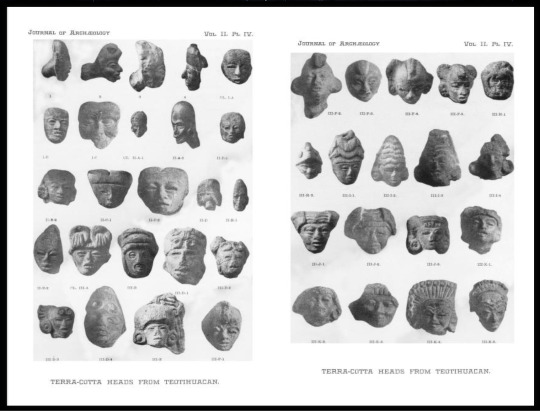
During the 1890s she became good friends with renowned patron of anthropology, Phoebe Hearst who is well known for being the namesake of the UC Berkeley Phoebe A. Hearst Museum of Anthropology. Hearst became a benefactor for Nuttall and often helped to fund her research.
Nuttall permanently moved to Mexico in 1902 and started working on pre-columbian manuscripts. Her most prominent work was on the Codex Zouche-Nuttall, a 14th century Mixtec manuscript that she helped to translate and analyze (pictured below). This codex was a facsimile, or recreation, of the actual deerskin book and it contained many scenes and narrative of Mixtec religion and culture.
*Brief aside: It is important to note that almost almost all the words that describe Indigenous peoples in the Americas (including the term America named for Italian explorer Amerigo Vespucci) are rooted in a colonial history. Terms such as ‘pre-columbian’ or ‘Latin-American’ are quite widely used throughout all academic literature, but it is still important to acknowledge their origins and understand why they can be problematic.

Nuttall strove to be an advocate for Indigenous Mexican traditions and worked to change their perceptions in archaeology. In 1928, Mexico held its first celebration of the Indigenous New Year since 1519. She passed away 5 years later in Coyoacán, Mexico.
Anthropology has a large history of racist methodologies and the common narrative toward pre-contact Mexican cultures cast Indigenous peoples as ‘savages’. While many white anthropologists and archaeologists of the time viewed Native Mexican peoples and cultures as “primitive”, Nuttall understood them as equals and as people that were intelligent and complex.
It is necessary to note that her ideology is flawed and born out of a 19th century mindset. She thought about her archaeological work in an idealized and romantic way, championing the concept that all humans can share and benefit from the shared heritage of Ancient Mexico. While the sentiment is nice, it is important to remember that it is generally not the place of western scientists to have autonomy over the knowledge of ancient cultures. It is disrespectful to try and push this type of universal narrative, and instead Indigenous communities and peoples should have their own decisions on the knowledge of their ancestral cultures.
That being said, there is something incredibly important in the way anthropology and archaeology is articulated through the perspective of a woman of color. Zelia Nuttall diverged from the traditional way her male contemporaries viewed the ancient Mexican cultures and she was revolutionary in the field of Mexican archaeology. Though some of her ideologies are outdated now, she was essential in changing the legacy of colonist mindsets toward Indigenous cultures.
Refs:
TOZZER, ALFRED M. "ZELIA NUTTALL". American Anthropologist, vol 35, no. 3, 1933, pp. 475-482. Wiley, doi:10.1525/aa.1933.35.3.02a00070. Accessed 23 Mar 2021.
"The Archaeologist Who Helped Mexico Find Glory In Its Indigenous Past". Smithsonian Magazine, 2021, https://www.smithsonianmag.com/science-nature/archaeologist-who-helped-mexico-find-glory-its-past-180970700/.
Nuttall, Zelia. "The Terracotta Heads Of Teotihuacan". The American Journal Of Archaeology And Of The History Of The Fine Arts, vol 2, no. 2, 1886, p. 157. JSTOR, doi:10.2307/495843.
"Zelia Nuttall - Wikipedia". En.Wikipedia.Org, 2021, https://en.wikipedia.org/wiki/Zelia_Nuttall.
"Codex | British Museum". The British Museum, 2021, https://www.britishmuseum.org/collection/object/E_Am1902-0308-1.
"Zelia Nuttall – Phoebe A. Hearst Museum Of Anthropology". Phoebe A. Hearst Museum Of Anthropology, 2021, https://hearstmuseum.berkeley.edu/zelia-nuttall/.
---------------------------------------------------------------------------
About the podcast: The I Dig It Podcast was created by Alyssa and Michaela in March of 2020. Our goal for this podcast was to provide archaeology enthusiasts with insight into the student perspective of navigating the world of academia and the job market for archaeology and anthropology. Guests on the podcast include people from all different parts of their career, including highschool, undergrad, grad school, post doc, and early career!
Where to Find Us:
Insta: https://www.instagram.com/idigitpodcast/
Twitter: https://twitter.com/IDigItPodcast
Discord: https://discord.gg/T7BPe36
ArchPodNet: https://www.archaeologypodcastnetwork.com/idigit
How to get involved: Sign up to be a guest or to be featured on our social media pages ➡️ https://linktr.ee/idigitpodcast
#women in archaeology#womens history month#women in science#anthropology#archaeology#cultural anthropology#ethnography#lingustics#mexican-american#women of color#history#mexican history#mixtec#aztec#archaeologypodcastnetwork#research#archaeologist#archaeologylovers#womens history#herstory#ethnohistory#anthropologist
304 notes
·
View notes
Text
On Linguistics
If you're familiar with Quebec, you know we have two official languages, and a recent strong push to add at least one third out of the handful of major Native American dialects spoken between the Saint Lawrence River basin and the upper North Coast. Unofficially, we have tertiary and, well, quarternary languages like Spanish and Mandarin.
The funny thing about my native language - French - is that Quebec's native speakers never really stepped off of a certain victimhood complex. I'm all for defending my native tongue, but I'm still a far cry from claiming that we're one or two generations away from ending up like certain Louisiana parrishes, where French is the focus of hyper-specialized classes attended by a nigh-on-invisible minority. We've got major Francophone news and media outlets, we can be served in French on a day-to-day basis, and being bilingual is, in many ways, more of a fun aside than a necessity.
More below.
Where I'm sort of confused is when my father prints out an article from Le Devoir that carries an editorial by Gérard Bouchard. For those who don't know, Bouchard is an author, a linguist, an essayist and a Postgrad professor that's focused on the particularities of French as spoken in Quebec. The article in question is titled Le Québec langue, which you could translate as meaning "Quebec as a language".
Said article is an exxagerated simulation of all of the anglicizations we use on a daily basis, and then ends with a sardonic note: the narrator is worried he'll have to pick up English for his new job, when he's spent twelve paragraphs with a roughly 50/50 ratio of French and English words in the same sentence.
The article doesn't pick sides, it simply illustrates a point. My father wags it in my face and says "See?! This is what your job is doing to you! This is how all of you Millennials sound; you can't find the right words for things in French even if not finding them would kill you!"
I look up from my script draft for Eastern Ontario - Kanata and the like - and realize I'll call a chunk of the country where a different set of roots for different idiolects of French has taken shape. Our English loan-words aren't the same in Ontario, and Franco-Ontarians have a deep history with so, used outside of its normal grammatical guidelines. It never implies a relation, but rather causation. "J'étais fatigué, so j'suis allé me coucher."
I ask my father to name one language of which the structure hasn't been altered by emergent technologies or new cultural trends. I tell him one springs to mind. He waffles for a bit, then admits defeat.
Latin. Latin is fixed in place. Latin doesn't shift, follow trends or alter itself to fit different regions. Latin has stripped itself of everything that isn't of scientific or religious importance, and only now are modern linguists attempting to piece it back together to the extent that it becomes a modern and complete conversation vector.
For all of the efforts of modern Latin schools, Latin is a dead language. The percentile of people who speak it at home is minuscule. The percentile involving everyday speakers is just as small. I remember seeing YouTube's Luke Ranieri pop-quiz deacons around the publically-accessible parts of Vatican City, and the only one who could hold a beginner-level conversation in Latin was Ugandan. The Italian, British and French deacons gave up after a scant few words.
That isn't the case for French. Millions of people use it everyday. It covers prose, everyday discussion, poetry, science, mathematics, emergent technologies, matters of faith and politics alike - it's alive. Just as alive as English is, and both languages are rife with new additions and subcultural plug-ins. You only need look at this freaking hellsite to see it for yourselves. This is the only place where saying you're writing a drabble on your scrunkly scrimblos wouldn't possibly raise eyebrows, and where you'd receive nods of understanding.
Of course, some purists see this as language being corrupted. I don't. French is alive precisely because it makes room for Anglicized words without rejecting its own French constructs. It's alive because I can speak to my IT colleagues in that language without feeling that there's a language level that's missing, in regards to, say, the need to reinstall Kubernetes or some colleague's missing credentials. I don't need to switch to a pidgin if I have to help out a colleague from the call center, and I also don't need to shoot for excessively formal constructs, either. Living languages are flexible. Latin isn't.
Predictably enough, however, this doesn't do it for my father and his dyed-in-the-wool Separatist roots. French is always under threat, as far as he's concerned, because we're geographically close to a basin that doesn't give a shit about our own culture - or so he believes. I always remind him that we're an annoyance to everyone in the ROC - who wishes we could just stick to English to make things easier for everyone - and a curiosity to people down south. To Americans, I'm a Budget Frenchman; a funny guy who gets American points of interest but who sometimes articulates them in a language that's rooted on the other side of the Atlantic.
As this brings up another thing: my French isn't even the "proper" French the Académie Française tries to drill into our heads at a young age, it's the French of colonists who left the Old Country in the late seventeenth and early eighteenth centuries. My French is the French of deported criminals and pardoned thugs, of provincial prostitutes and uneducated guys and gals tossed halfway across the globe on vain promises of royal cash and an allotted plot of land. My French is to French what Texas' drawl is to Elizabethan English, or what Ottawa's vaguely-Celtic consonants are to Australia's open vowels.
So what is there to defend, here? Do we cling to some arbitrary definition of a "proper" idiolect and insult everyone between myself and my fellow Cajun speakers between Montreal and Biloxi, or do we accept what linguistics teaches us, and that all signs, all signifiers, are arbitrary? Languages just can't evolve without that central aspect, that understanding that those who make up the sounds and structure of a language are its speakers.
#long post#linguistics#tumblrspeak#french#english#languages as arbitrary constructs#cultural sentiment#i'll never apologize for my copious frenglish out of the office
6 notes
·
View notes
Text
Kobayashi’s Maid Dragon S2 Episode 10 Notes

I’m extremely not an expert in birds, but I tried to look these up to see if they were a species native to New York (since they’re similar to the sparrows we usually see around Kobayashi’s place). Apparently there are few similar-looking species in New York? My totally uninformed guess is that they may be house sparrows.

The sun sets in Japan relatively early (probably around 6:30pm when this episode takes place), which would make it entirely plausible that if she just flew east (with a slight northward angle) she’d find herself over New York in the early morning while most of the rest of the country is still dark.

These bumpy grey pads at the pedestrian part of the intersection here are known as (among other things) tactile paving; they’re to assist people who can’t fully rely on eyesight to get around.
Interestingly (imo), they were actually invented in Japan in the 60s (by a Miyake Seiichi), where today they’re extremely ubiquitous. They even show up later this episode!

They’re often referred to in Japan as 点字ブロック, tenji (Braille) blocks, and they tend to come in two types: the “dot” design, which indicates a place to stop (or an angle change, or more generally “caution”), and the “line” design which indicates you can safely keep going. They’re generally colored yellow in Japan, ideally making them stand out more to help people with impaired vision find them, and are mandated by law in most places public transport can be found (among others).



Not really a translation note, but “deer cola” felt especially funny in the context of all the horse medicine stuff.
I guess “[animal] [drink]” is a common branding device in-universe, given the crab beer Kobayashi’s always drinking.

Also not really a translation note, but the difference between how “hard” Kanna and Chloe are running to be at the same speed was a nice animation touch.

遊んだ遊んだ! asonda asonda!
One feature of the Japanese language is a very heavy use of repetition. This includes “reduplication,” a linguistic term for creating words by repeating a root (e.g. a “boo-boo” in English or the dara-dara example below in Japanese), but also just like… saying the same word multiple times, as Chloe does here.
Typically this is done for emphasis or to help increase clarity: if you’ve worked in a Japanese office, you’ve likely heard someone in a phone conversation say desu desu in response to someone asking for confirmation.
This acceptance of repetition sort of extends beyond the obvious uses like this as well: for example, personal pronouns are much less common; instead (if the subject isn’t dropped) you’ll often just use the person’s name again. You’ll notice similar trends with other types of words as well.
Not to mention the ubiquity of things like otsukare.
This often ends up being a challenge for translators, because reusing words in English (when it’s not for an obvious reason) tends to stick out rather unflatteringly, even if they aren’t that close together.
(Like when I overuse “hence” in these notes.)

This “Christ” in the Japanese was “ったく” (short for 全く mattaku, but just used as a semi-generic exclamation). I mostly bring this up because it’s a good example of a word that doesn’t work out of its cultural context; e.g. it wouldn’t make any sense for a fantasy character to say “Christ,” but since this is an American speaker it works just fine (and helps distinguish that fact, even).
I think I’ve mentioned this before, but English uses a lot of “explicit reference” words like this, that can break immersion if put in the mouths of characters who wouldn’t have exposure to said reference—which can be annoyingly limiting when trying to write dialogue sometimes.

As a bit of a culture shock for a lot of Americans I’ve met, most Japanese homes tend to have wall mounted air conditioning units, like this one, that are only for heating/cooling the one room they’re in. (Many also have a “Dry” setting that makes them act kind of like a dehumidifier as well.) It’s common to not have them in every room, like bedrooms, however.
This is in contrast to the central air conditioning system used by a majority of homes in the US (though type/use of AC in the US varies a lot by region; less common in the north for example)—and places like the UK where apparently residential AC units of any kind are quite rare.
You may have noticed that the doors between rooms always seem closed in Kobayashi’s apartment. That’s not just to make the backgrounds simpler, it’s also a good habit to keep if you’re going to be running the AC!


“Kobayashi, are you お休み today?”
“Yeah, お休み.”
お休み o-yasumi, is a noun form of the 休む yasumu, to rest. The word has a variety of applications, as we see here. A day off work/school, i.e. a rest day? お休み. Want to say “good night” to someone before bed? Also お休み.
In this case, it’s not even necessarily clear it’s being said as a pun; as mentioned earlier, repetition is a common feature of the language, so despite the yawn there wouldn’t really be any reason for Kanna to think Kobayashi was about to go to nap or anything.

“Laze about” here is だらだら dara-dara, another phenomime (擬態語 gitaigo in Japanese)—one of those words that mimics the “sound” of an idea/concept/state, which don’t actually make a sound per se.
These phrases aren’t necessarily childish or anything (overuse of them can be, but you can find them even in news articles and political speeches for example). They are, however, used frequently by children, and by adults talking to children, as they’re very “easy” words: they’re expressive, they capture useful daily-life concepts, and they usually roll off the tongue. You’ll notice, for example, that Kanna uses them a lot.
Kanna has a very interesting way of talking actually, which I’ll touch on a bit more later.


Kobayashi’s “bean jam” here is あんみつ anmitsu, a traditional Japanese dessert (technically a spinoff of mitsumame). It typically is a mix of red beans (and/or red peas), agar (an algae-based gelatin equivalent), some fruit, some variety of rice flour product (shiratama in this case, similar to mochi), and a syrup (often black sugar based).
You can find it year-round, but it has a strong summer association and is even used as a summer season word. (It’s typically chilled and you can often get it with ice cream as an ingredient.)
It’s also sometimes paired with a green-tea flavored something as well (e.g. ice cream, agar, or syrup). The trinity of green tea, red beans (aka azuki), and shiratama makes what I like to think of as the “Japanese S’mores Flavor (for Adults)”. No I will not elaborate on this.
I will though point out the shaved ice flavor Kobayashi ordered later in the episode:

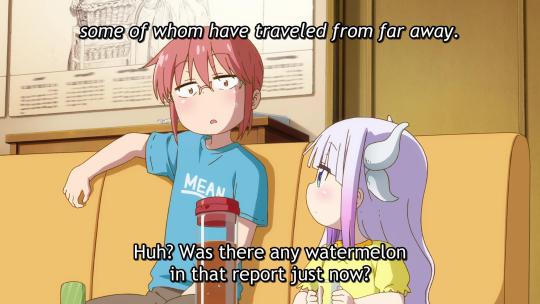
え?今スイカ様子あった?
A word of note here for language learners is 様子 yousu, which has a lot of definitions, but in cases like this where it’s attached to a noun or phrase means roughly “the appearance of __” or “an indication of ___” etc. In actual use, it typically means something that makes you think of whatever ___ is—or the lack of something that would make you think ___.
For example here, it’s like “Watermelon? Where’d that come from?” (since the TV was talking about a different dessert-y food entirely).
Or an unrelated example: “I think that guy is hiding something” → “Really? I haven’t seen any yousu of that.” In other words, it can be a lot like “sign,” as in “I’ve seen no sign of ___.”

These color-bordered envelopes (originally colored based on the flag of the country of origin) used to be the standard for air mail, domestic or international, though they haven’t been required for several decades.
That said, they’re still popular for that “ooh, international mail!” feel (at least in Japan) and you can buy them at most places that sell stuff like envelopes. As here, they’re often used in media to immediately convey that a letter came from outside Japan.
Kanna (and Kobayashi) says エアメール, lit. “air mail” in English, which is used colloquially for international mail specifically, rather than “mail sent by plane.”


They’re having what’s called 冷やしそうめん hiyashi soumen, chilled/cold soumen for lunch here. (Soumen being a thin wheat noodle; udon but thinner.) As Kanna says, it’s very easy to make!
Basically you just boil it, wash it in cold water, add ice, get some sort of sauce to dip it in, and you’re done! It’s a popular quick meal in summer, and much easier than the more involved nagashi soumen setups you may have seen elsewhere, where they slide the noodles down a chute for you to try to grab and eat. (It’s basically the same meal aside from that though.)
(You can of course add more to it, but as we see here, you don’t really have to.)

The type of tea here, for the curious, is 麦茶 mugicha, barley tea. Mugi is the general name for cereals/grains including wheat (komugi), barley (oomugi), rye (kuromugi or rye mugi), and oats (enbaku or oat mugi). It’s incredibly common in Japan (and much of East Asia), where it's the household summer drink.
It has no caffeine like many other teas, and has a bunch of various nutritional benefits, so it’s considered a good way to stay hydrated as you’re sweating buckets in the muggy Japanese summer weather.


帽子した? boushi shita?
した! shita!
I thought this was a cute way of phrasing this question/answer, and a good example of the “parent and their young child” way these two talk.
The suru (past tense shita) verb used here is the ultimate in “generic verb,” and it basically doesn’t get any simpler grammar-wise to phrase something as “noun+suru” like Kobayashi does here (even the particles are dropped).
Kanna, for her part, doesn’t respond with a “yes” or etc, but instead just repeats back the verb itself in confirmation.


Just to note another one of those words like dara-dara: bura-bura, used for things like wandering around, doing something (or nothing) casually/aimlessly, or (with one bura) for something dangling/swinging in a more literal sense, like a spider, slack yo-yo, or wind chime.
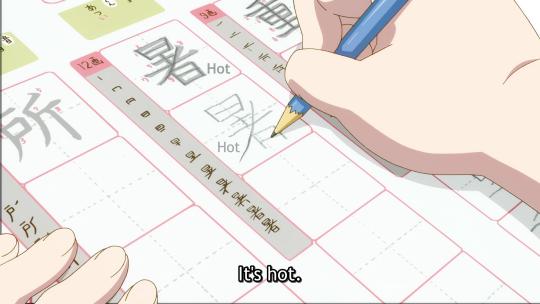
These booklets are a common homework assignment for practicing kanji; you can see along the left side there it shows the stroke order, with the first block giving an example to trace over & showing where to start each stroke.
Each character is made up of radicals (e.g. “hot” above: 日 and 耂), which each have a standard way to write them. There’s 214 such radicals (though many are pretty niche; only about ~50 of them are needed to make most characters), and once you get a hang of them it makes learning new characters much easier (not too different from learning word spellings in English imo).
Kanna is repeating out loud the reading for the “hot” character as she writes it.


In addition to the above workbooks (which usually involve both kanji and math problems at Kanna’s grade), elementary school summer homework in Japan typically involves doing an illustrated diary (not a daily one necessarily) and some sort of research project about a subject of your choice. (Think kind of like a small science fair project).
The “research” project part is pretty expansive, and you can typically even do something more arts & craftsy for it.
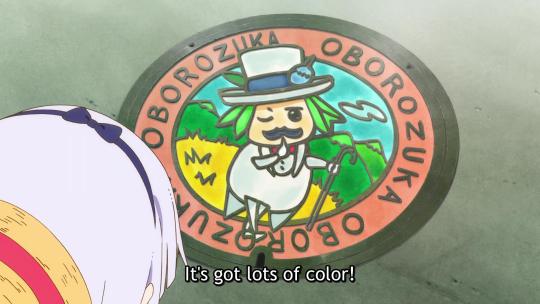
Manhole covers in a lot of Japanese municipalities feature art representative of the area. For example, the city of Chofu, where the author of GeGeGe no Kitaro lived most of his life, has several with art of that series.

(Photo from https://www.gotokyo.org/jp/spot/1734/index.html)
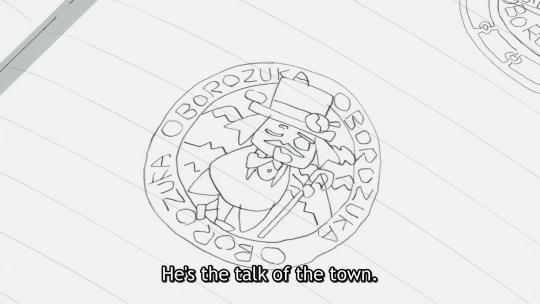
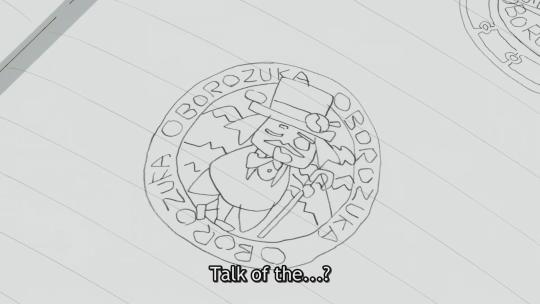
I mentioned earlier that Kanna has an interesting way of speaking. Probably a better way to put it is that she has a pretty convincingly childish way of speaking (despite the monotone). That is, she uses simple grammar and “easy” words most of the time, but then throws out random big words and fancy idioms from time to time that make you go “...where did you learn that?”
In this case, the phrase she uses is 巷で人気 chimata de ninki. Chimata originally means like a fork (in the road), and since those are often places with lots of people passing through, it expanded to mean “the undefined place where people talk about ~stuff~.” So it’s used for “many people are saying~” or “word on the street is~” types of situations (or “talk of the town,” as here).
It’s kind of an “adult” word though; for example the character for it isn’t included in the jouyou kanji (the 2000+ that are taught in elementary through high school). Hence Kobayashi’s reaction here.

The word she uses for “protected” here is 死守 shishu. The word is the combination of the characters for “death” and “protect,” ~meaning to protect something even at risk to one’s life (to the death, as it were).
It's a word that you learn in third grade in the Japanese education system—the same grade Kanna is in!


Both of these types of signs are common sights in residential areas like this: depending on where you live, it can feel like there’s always some sort of construction project going on, and Japan’s many family/individually-owned businesses like this tend to be closed on various extra days during the summer (and certain other times) to allow for time off.
In this case, them being closed August 12th~16th implies they’re taking off for Obon (and probably leaving town to visit family).
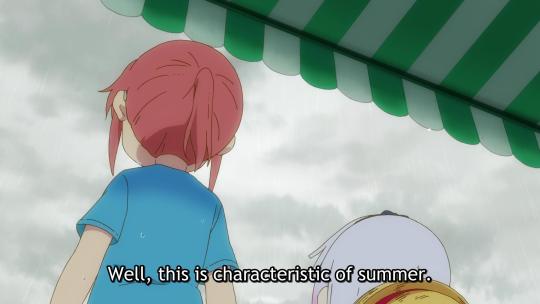
The word Kobayashi uses here is 風物詩 fuubutsu-shi. Fuubutsu refers to something that makes up part of the “scenery” of a place or season, in a pretty broad sense. This shi typically means “poem.”
So fuubutsu-shi is originally a type of poem celebrating a season or a scene of natural beauty, that sort of thing. From that, it’s also now (more popularly) used to describe things that are representative of a season; the kind of stuff you say “it’s not winter until…” about, or “you know it’s summer when…” (It can also be used for places + seasons, like the ice sculptures of Hokkaido winters, or even summer Comiket in Tokyo.)
They’re very similar to the season words I’ve mentioned previously, though they’re far less strict about what counts as one. Here, Kobayashi’s could be referring to the whole package experience of “having to take cover and wait out a sudden heavy rain, despite it being mostly clear skies a few minutes ago,” which you could call fuubutsu-shi (summed up probably as like 夏の雨宿り etc.)
In contrast the relevant season word here would probably be yuudachi (or niwaka-ame), a word referring to the short, sudden bouts of rain that tend to fall (from cumulonimbus clouds, the makings of which are noticeable in the backgrounds before this) on summer evenings.

Feels like in season one she woulda eaten it. Three cheers for character growth!
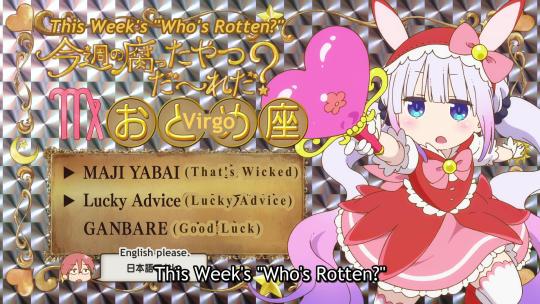
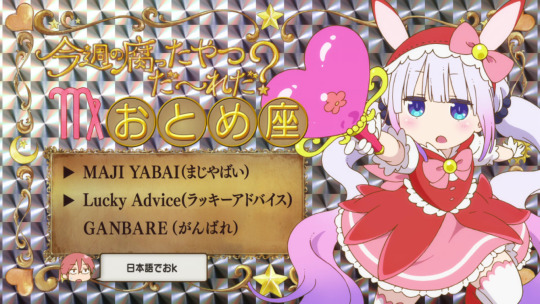
The parentheticals there are just the “English” in hiragana/katakana.
Kobayashi’s comment (nihongo de ok, roughly “you can just use Japanese”) is an internet-born term people originally would use to reply to someone who said something that didn’t make any sense, had terrible grammar, or was so full of katakana loanwords it was hard to read etc.
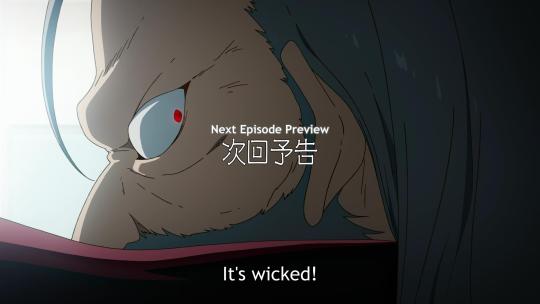
Kanna says this line in English, and while I have no proof at all, my guess is that the specific choice of “wicked” was taken from the translation of “maji yabakune?” used in season one.
13 notes
·
View notes